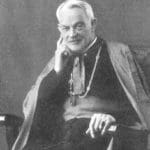THE FINDING IN THE TEMPLE
“And it came to pass that after three days they found Him in the Temple, sitting in the midst of the doctors, hearing them, and asking them questions. And all that heard Him were astonished at His wisdom and His answers. And seeing Him they wondered. And His Mother said to Him, ‘Son, why hast Thou done so to us? Behold, Thy father and I have sought Thee sorrowing.’ And He said to them: ‘How is it that you sought Me? Did you not know that I must be about My Father’s business?’ And they understood not the word that He spoke unto them.”
Luke 2:46-50
1. We have elsewhere seen how our Lord sanctioned and sanctified many phases of human life by His own hidden life at Nazareth. But here we have one special feature as it were taken apart and solemnly consecrated apart; the feature of education. Of course, later in life He sanctified it in abundance by His life of public teaching; but there is a special appropriateness in this earlier consecration, when He Himself was in the role of a pupil, and when in this formal way, in the Temple itself, He could solemnly sanctify that all-important work which the Church has ever claimed for her own. Is it not true to say that there is on earth no more sure means of securing one’s own salvation than that [of] religious teaching, nor any surer way of doing good to others? There is joy for many in this certainty; for many who of all people in the world are perhaps most in need of encouragement.
 2. Mary and Joseph found Him in these surroundings. They saw the Child sitting among the listeners; they noticed the attention He had attracted; they read in the faces of the doctors that He had impressed them. How, we do not know; but when Mary “pondered in her heart” all she saw and heard, she must have rejoiced at this first shining of the Light that had come into the world. There was joy in the mere finding of the Child; there was an added joy in finding Him where He was, doing what He was [doing]; it was a sign to her of the special work which was near to His heart, and therefore which was near to her own. As we contemplate the scene it seems impossible to believe that her words recorded by St. Luke followed immediately upon the finding of the Child. There was much between; above all the joy. “I have found Him Whom my soul loveth; I have held Him and will not let Him go.”
2. Mary and Joseph found Him in these surroundings. They saw the Child sitting among the listeners; they noticed the attention He had attracted; they read in the faces of the doctors that He had impressed them. How, we do not know; but when Mary “pondered in her heart” all she saw and heard, she must have rejoiced at this first shining of the Light that had come into the world. There was joy in the mere finding of the Child; there was an added joy in finding Him where He was, doing what He was [doing]; it was a sign to her of the special work which was near to His heart, and therefore which was near to her own. As we contemplate the scene it seems impossible to believe that her words recorded by St. Luke followed immediately upon the finding of the Child. There was much between; above all the joy. “I have found Him Whom my soul loveth; I have held Him and will not let Him go.”
3. But when the first thrill was parsed, when she had become sure that He was again her own, then the reflection on the mysterious behaviour was natural. “They understood not”; even after her Son had spoken they did not understand. So naturally she asked, not complaining, or doubting, as she did not complain or doubt when she asked for understanding at the Annunciation. But the fact was there. For once the Child had given the father and Mother pain, a strange thing indeed. Why? “My Father’s business”; no more. Still she “understood not”; how should she? But now she understands. She knows now why on that occasion a sword pierced her soul, “that out of many hearts, thoughts might be revealed.” She hears now how for those three days of suffering “all generations have called her blessed.”
Summary Meditation Points:
- Our Lord in the Temple is the consecration of the Christian school.
- The finding in the Temple was a double joy to Mary, in the Child, and in His work.
- But there had been sorrow, which must have had a cause; that cause is the lesson it taught mankind.
 Editor’s Note: This meditation is from Archbishop Alban Goodier’s “The Prince of Peace” (1913).
Editor’s Note: This meditation is from Archbishop Alban Goodier’s “The Prince of Peace” (1913).





